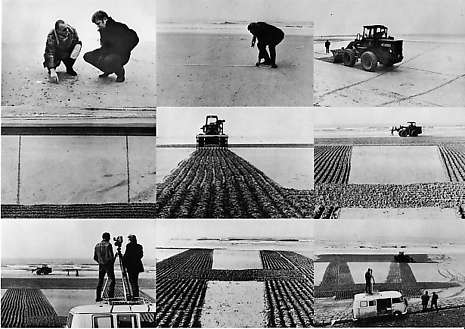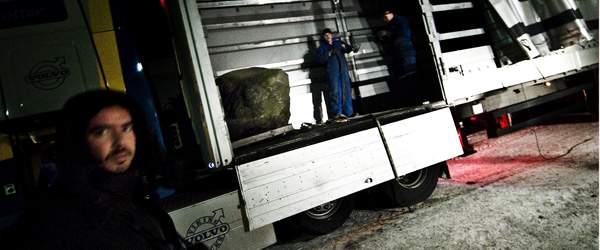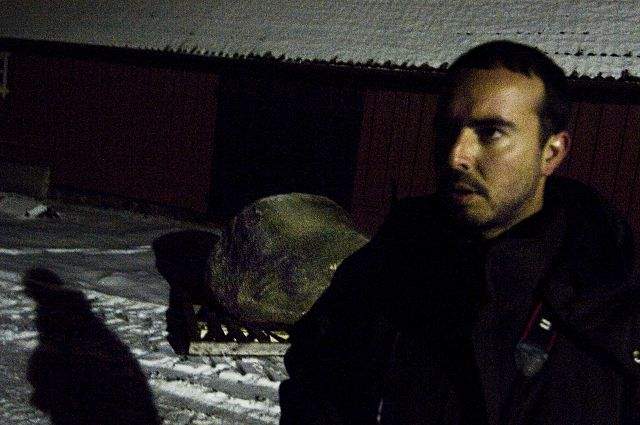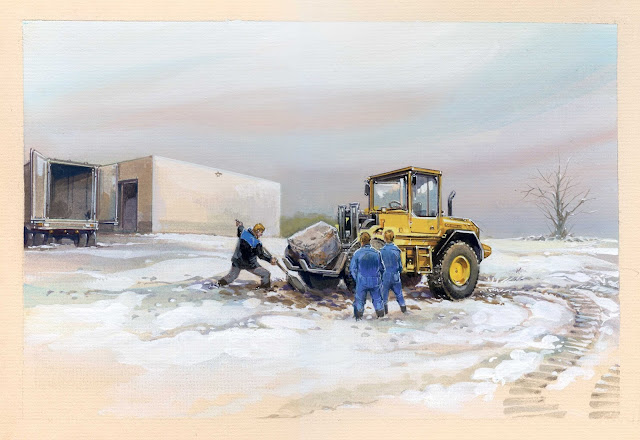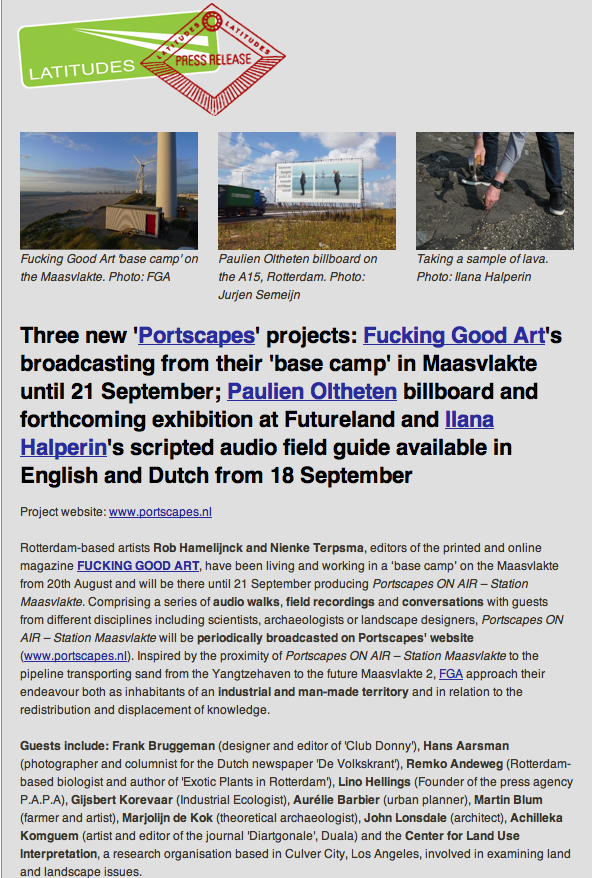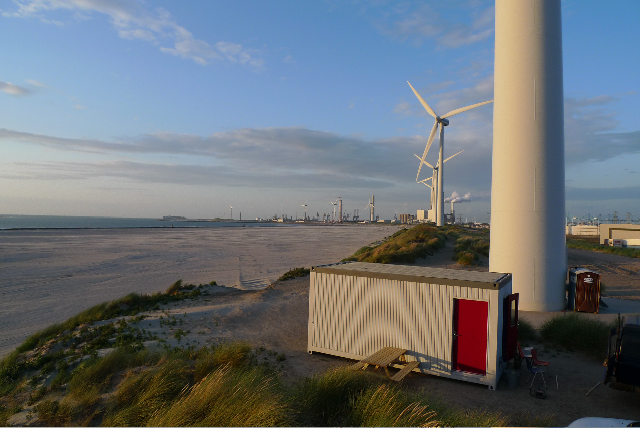...a year ago on the Maasvlakte beach, Rotterdam
Mon, Feb 8 2010
Production stills while filming the 1969 '12 Hours Tide Object with Correction of Perspective', in the Dutch coast near Zandvoort. The film was consequently included in Gerry Schum's Land Art TV.
Production stills, '6 Hours Tide Object with Correction of Perspective' in Maasvlakte beach, 8 February 2009. Photos: Latitudes, Paloma Polo/SKOR and Freek van Arkel.
Dibbets realised the original version of this classic work on the Dutch coast near Zandvoort in February 1969 and this 'second attempt' (the artist rejects the notion of a ‘remake’) was shot forty years later to the month, in February 2009 on a beach that will disappear with the construction of Maasvlakte 2. The eight minute film was premiered in the FutureLand visitor centre every Sunday during June 2009 and was screened on loop in New York, during Latitudes' participation in the non-profit festival 'No Soul for Sale' (24–28 June).
6 Hours Tide Object... records the drawing of a trapezoid shape in the sand during low tide using a bulldozer which drives back and forth along the beach. The shape consequently appears as a rectangular ‘frame’ in the resultant film due to the angle of perspective distortion in being shot from an elevated platform. Subsequently, the incoming tide washes it away. A formalistic reflection on geometry, representational illusion and the camera-’eye’, Dibbets reasserts the freshness of this fleeting filmed action with no hint of nostalgia. Within the context of the development of Maasvlakte 2 the work allows our fresh interpretations: concerning the physical modification of Dutch coastline, or new perspectives of construction, destruction and change, for example.
Watch the 'making of' by Olaf Schuur.
6 Hours Tide Object... was produced in the context of 'Portscapes', an accumulative series of ten new commissions by initiated by the Port of Rotterdam Authority with advice and financial support from SKOR (Foundation Art and Public Space, Amsterdam) curated by Latitudes, Barcelona.
An exhibition is currently on view at the Museum Boijmans Van Beuningen with the resulting works realised throughout 2009. On view until 25 April 2010 - free entrance.
Portscapes: Jorge Satorre returns an ice-age boulder back to Sweden
Mon, Jan 18 2010Jorge Satorre's project for Portscapes had its beginnings in the eastern part of the Netherlands with a 3-tonne gneissic granite rock from the Svecofennian age, approximately 1.9 billion years ago. Following the artist’s fascination with the environmental compensation practices being instigated alongside the construction of Maasvlakte 2, his project consisted of returning the rock to where it once came from in Sweden – an act of synthetic restitution and transnational sculptural offsetting.
The boulder has now found a permanent home at the Wanås Foundation, near Knislinge in southern Sweden [1]. The boulder was transported from Erica, in the northeast of The Netherlands, to Knislinge at the beginning of January (see report on the Swedish newspaper Kristianstadsbladet).
Not insignificantly, the celebrated Land art work 'Broken Circle' (1971) by Robert Smithson, sited in a working quarry near Emmen, incorporates such a seemingly immovable boulder at its centre. Satorre’s reverse geological gesture is also reflected in the fact that much of the existing and future sea defence in the port area will be made from rock brought from Scandinavia. The artist offers an account of the process through drawings, which incorporates both actual and imagined details. One such detail depicts an imagined protest at the beginning of the boulder’s homeward journey – see post 2 October 2009.
Jorge Satorre's project was produced in the context of 'Portscapes', an accumulative series of newly commissioned projects produced in the context of the 2,000-hectare extension to the Port of Rotterdam, the project Maasvlakte 2.
An exhibition with 'Portscapes' projects will be on view at the Museum Boijmans van Beuningen, Rotterdam between 30 January and 25 April 2010 (Reception: Friday 5 February, 20h).
Portscapes was commissioned by the Port of Rotterdam Authority with advice and support from SKOR (Foundation Art and Public Space, Amsterdam) and was curated by Latitudes.
[FOOTNOTE 1] The foundation estate encompasses a medieval castle, an organic farm, and a sculpture park which since 1987 has hosted a number of permanent works by international artists.
Images: Journey and placement of the boulder from the newspaper Kristianstadsbladet; Drawings of 'The Erratic. Measuring Compensation' (2009), courtesy of the artist.
Portscapes news: Jorge Satorre's billboard on the A15 and Paulien Oltheten small exhibition at the visitor centre Futureland and surroundings
Fri, Oct 2 2009Placed along the A15 highway on the Maasvlakte, Jorge Satorre's billboard is the third installed as part of 'Portscapes' – joining those by Hans Schabus and Paulien Oltheten.
During the summer of 2009, Jorge Satorre was searching for, and eventually located, a large boulder – specifically one of the giant rocks carried by glaciers into The Netherlands from Scandinavia during the last Ice Age. Following the artist’s fascination with the environmental compensation projects being instigated alongside the construction of Maasvlakte 2, his project seeks to identify this rock’s precise place of origin and then return it to where it came from – an act of synthetic restitution and transnational sculptural offsetting. Satorre’s reverse geological gesture furthermore mirrors the monumental construction of the Maasvlakte 2 as a sculpting of land-form which, like the action of ice but in a far shorter time, is fundamentally altering the morphology of The Netherlands. The action is also reflected in the fact that much of the existing and future sea defense in the port area will be made from rock brought from Scandinavia. The artist’s accompanying pencil drawings offer an account of the process which incorporate both actual and imagined details, like a storyboard. A single drawing which depicts an imagined protest at the beginning of the boulder’s journey is realised as a billboard near the Futureland visitor’s centre.
A second part of his research will be presented at the Portscapes exhibition at the Museum Boijmans van Beuningen from 5 February 2010.
Paulien Oltheten's videos and photographs can also be seen until mid-November 2009 in and around Futureland, the Maasvlakte visitors’ centre [MAP HERE]. From there, visitors can set off with a route description to the locations on the Maasvlakte where other work can be seen.
Locations and some images of Oltheten's mini-billboards:
The public domain and human behaviour is the starting point for the work of Paulien Oltheten (1982), though she has described her approach as closer to that of an anthropologist rather than artist. With her still and video cameras, she generally searches with apparent casualness for moments when there is contact between people, objects and public space. On the Maasvlakte, Oltheten was faced with the fact that the familiar frame of reference of natural elements, such as trees, bushes and people, was almost completely lacking. Oltheten decided to make use of this alienation by arranging meetings with people. This resulted in a series of photographs and two short video pieces. These stagings mostly take place in locations on the Maasvlakte that will disappear or be displaced during the coming years. The photographs and videos are sometimes variations on the theme of ‘one becomes two’, referring to the Maasvlakte, of which there will later be two.
Futureland is on Europaweg 909, 3199 LC Maasvlakte, Rotterdam (Havennummer 8213). It is across the road from the E.ON power plant. Open Tuesday-Friday 10am-5pm and on Sunday 11am-5pm. Entry is free. Map here.

Portscapes is a series of public art commissions initiated by the Port of Rotterdam Authority with advice and support from SKOR (Foundation for Art and Public Space, Amterdam) and curated by Latitudes. www.portscapes.nl
[Photos of Jorge Satorre's board by Ben Wind; Photos of Paulien Oltheten's by the artist and Ben Wind.]
Three new 'Portscapes' projects: Fucking Good Art, Paulien Oltheten and Ilana Halperin
Mon, Sep 14 2009Three new 'Portscapes' projects: Fucking Good Art's broadcasting from their 'base camp' in Maasvlakte until 21 September; Paulien Oltheten billboard and forthcoming exhibition at Futureland and Ilana Halperin's scripted audio field guide available in English and Dutch from 18 September 2009
Project website: www.portscapes.nl
More info on this projects here
Rotterdam-based artists Rob Hamelijnck and Nienke Terpsma, editors of the printed and online magazine FUCKING GOOD ART, have been living and working in a ‘base camp’ on the Maasvlakte from 20th August and will be there until end of September producing Portscapes ON AIR – Station Maasvlakte. (+ info...)
On 14 August 2009 a billboard by Amsterdam-based artist PAULIEN OLTHETEN was placed along the A15 on the Maasvlakte. Oltheten made use of the lack of reference of natural elements, such as trees, bushes and people by arranging meetings. These stagings mostly take place in locations on the Maasvlakte that will soon disappear or be displaced and often involve variations of the theme ‘one becomes two’, referring to the Maasvlakte, of which there will later be two. (+ info...)
As her contribution to Portscapes, New York-born Glasgow-based artist ILANA HALPERIN has created an audio field guide available online and on MP3 players which visitors will be able to pick up at Futureland (map here) and experience through wandering the nearby area of the port edge. ‘A Brief History of Mobile Landmass’ is inspired by a perception of Maasvlakte 2 in terms of formidable geophysical phenomena and a geological sense of time. (+ info...)
Audioguide available online and at Futureland (map here) from 18 September 2009 until 2013. Narrated in English and Dutch. Duration: 45 min.
–
'Portscapes' is an accumulative series of art commissions taking place throughout 2009 alongside the construction of ‘Maasvlakte 2’, a 2,000 hectare area of reclaimed land that will extend the Port of Rotterdam, Europe's largest seaport and industrial area by 20%. Projects varied in size and scale will be produced under the leitmotif itineraries and destinations comprising tours, audioguides, performances, radio programmes, interventions, for example. (+ info...)
Artists involved in Portscapes: Lara Almarcegui, Bik van der Pol, Jan Dibbets, Marjolijn Dijkman, Fucking Good Art, Cyprien Gaillard, Ilana Halperin, Roman Keller & Christina Hemauer, Paulien Oltheten, Michael Rakowitz, Jorge Satorre, Hans Schabus and Jun Yang. Website collaborators: Maria Barnas (poetry) and Markus Miessen (interviews).
Read more on completed projects and on projects in production.
'Portscapes' press coverage here. To receive Portscapes news sign up here.
'Portscapes' is commissioned by the Port of Rotterdam Authority with advice and support from SKOR (Foundation for Art and Public Space) and is curated by Latitudes.
Fucking Good Art 'base camp' in Maasvlakte, Rotterdam, until 21 September
Wed, Sep 2 2009
Images of the 'base camp' and surroundings where the editors of Rotterdam-based printed and online art magazine Fucking Good Art will be until 21 September. All images courtesy FGA.
Initiated and edited by artists Rob Hamelijnck and Nienke Terpsma in 2003, Fucking Good Art is a Rotterdam-based printed and online art magazine which publishes reports, interviews, critical writing and observations with a non-academic, freestyle and do-it-yourself attitude. The editors of FGA explores creative communities by residing in particular local contexts for extended periods, and specific magazine issues have grown out of residencies in cities including Munich, Berlin, Copenhagen, Riga, Zurich and São Paulo.
Adapting their embedded approach for Portscapes, the editors of FGA are living and working in a ‘base camp’ on the Maasvlakte for 5 weeks, starting 20 August while producing Portscapes_ON AIR. Comprising a series of audio walks, field recordings and conversations with guests from different disciplines Portscapes_ON AIR will be broadcast on the internet (www.portscapes.nl).
Inspired by their camp’s proximity to the pipeline which carries sand from the Yangtzehaven to the future Maasvlakte 2, the editors of FGA approach their endeavour both as inhabitants of an industrial and man-made territory and in relation to the redistribution and displacement of knowledge. Alongside other grand movements of transportation and trade taking place in the port, FGA’s broadcasts take shape through encounters with others and consider the role that art and artists have in other registers of exchange. Starting from the principal that in order to really understand a place one needs to really inhabit it, and the question of how to represent a place like as Maasvlakte 2 which does not yet fully exist, the editors of FGA also aim to stimulate discussion about the representation of Dutch landscape. They hope that their project could be pilot for a further research residencies.
Participants contributing to Fucking Good Art's research on Maasvlakte and webradio:
Frank Bruggeman: Designer, artist and one of the editors of 'Club Donny', a strictly unedited journal on the personal experience of nature in the urban enviroment.
Hans Aarsman: Former photo journalist, and currently columnist for the Dutch newspaper "De Volkskrant" and playwriter. In 1988 he travelled for one year in Holland in his camper van - a Citroën HY - to produced the book 'Hollandse Taferelen'. He has published several publications: the photo book 'Aarsmans Amsterdam' (1993), his first novel 'Twee hoofden, een kussen' (1995) and in 2003 the autobiographical book 'Vrrooom! Vrrooomm!'. Some of his photos are free for download at the Nederlands Fotomuseum.
Remko Andeweg: Botanical analyst, City biologist of Rotterdam and author of the book 'Vreemde Planten in Rotterdam' [Exotic plants in Rotterdam, 2002], about the migration of plants that are considered foreign and endanger domestic vegetation.
Lino Hellings: Errorist! Recently founded the press agency P.A.P.A, an international network of artists and correspondents that creates news by taking action. Co-author of the publication "An Architecture of Interaction", and one of the founders of Dogtroep (1975), a self-styled form of visual theatre.
Gijsbert Korevaar: Industrial Ecologist.
Aurélie Barbier: A French urban planner specialised in emerging cities. Currently working for Urbaplan, an urban planning firm based in Switzerland. She has worked on various projects in Southern Europe and sub-Saharan African countries (Cameroon, Niger, Ghana). Over the past five years, she has focused on the definition of master plan, regulatory plan and slum upgrading projects through a comprehensive approach that includes both social and technical dimensions of urban development.
Martin Blum: Swiss artist and farmer. Works together with Haimo Ganz under the name GANZBLUM. In their art projects they focus on (life)cycles. Martin recently started public art projects on his farm "Frohe Aussicht" outside Zurich.
Marjolijn de Kok: Theoretical archeologist specialised on settlements and the wetlands of Holland. Also co-publisher of LIMA.
John Lonsdale: Architect. In the last years he has begun mapping the ‘Mudscapes of the Netherlands’ whereby he strives for the reconciliation of architecture with landscape.
Achilleka Komguem: Artist from Duala. Editor of journal 'Diartgonale' and worked on a radio show in Bessengue. He is in visiting Holland for 'Talking about!' a project by curators Zoë Gray and Lucia Babina that brings six artists and cultural producers from Cameroon to the Netherlands. FGA are hosting Achilleka during his visit.
CLUI: The Centre for Land Use Interpretation is a research organisation based in Culver City, Los Angeles, involved in exploring, examining, and understanding land and landscape issues. The Center employs a variety of methods to pursue its mission - engaging in research, classification, extrapolation, and exhibition. http://www.clui.org
Portscapes is commissioned by the Port of Rotterdam Authority with advice from SKOR (Foundation for Art and Public Space, Amterdam) and is curated by Latitudes. Read more on completed projects and projects in production.
Fucking Good Art, Maasvlakte 2, Port of Rotterdam Authority, Portscapes, Rotterdam, SKOR
Adapting their embedded approach for Portscapes, the editors of FGA are living and working in a ‘base camp’ on the Maasvlakte for 5 weeks, starting 20 August while producing Portscapes_ON AIR. Comprising a series of audio walks, field recordings and conversations with guests from different disciplines Portscapes_ON AIR will be broadcast on the internet (www.portscapes.nl).
Inspired by their camp’s proximity to the pipeline which carries sand from the Yangtzehaven to the future Maasvlakte 2, the editors of FGA approach their endeavour both as inhabitants of an industrial and man-made territory and in relation to the redistribution and displacement of knowledge. Alongside other grand movements of transportation and trade taking place in the port, FGA’s broadcasts take shape through encounters with others and consider the role that art and artists have in other registers of exchange. Starting from the principal that in order to really understand a place one needs to really inhabit it, and the question of how to represent a place like as Maasvlakte 2 which does not yet fully exist, the editors of FGA also aim to stimulate discussion about the representation of Dutch landscape. They hope that their project could be pilot for a further research residencies.
Participants contributing to Fucking Good Art's research on Maasvlakte and webradio:
Frank Bruggeman: Designer, artist and one of the editors of 'Club Donny', a strictly unedited journal on the personal experience of nature in the urban enviroment.
Hans Aarsman: Former photo journalist, and currently columnist for the Dutch newspaper "De Volkskrant" and playwriter. In 1988 he travelled for one year in Holland in his camper van - a Citroën HY - to produced the book 'Hollandse Taferelen'. He has published several publications: the photo book 'Aarsmans Amsterdam' (1993), his first novel 'Twee hoofden, een kussen' (1995) and in 2003 the autobiographical book 'Vrrooom! Vrrooomm!'. Some of his photos are free for download at the Nederlands Fotomuseum.
Remko Andeweg: Botanical analyst, City biologist of Rotterdam and author of the book 'Vreemde Planten in Rotterdam' [Exotic plants in Rotterdam, 2002], about the migration of plants that are considered foreign and endanger domestic vegetation.
Lino Hellings: Errorist! Recently founded the press agency P.A.P.A, an international network of artists and correspondents that creates news by taking action. Co-author of the publication "An Architecture of Interaction", and one of the founders of Dogtroep (1975), a self-styled form of visual theatre.
Gijsbert Korevaar: Industrial Ecologist.
Aurélie Barbier: A French urban planner specialised in emerging cities. Currently working for Urbaplan, an urban planning firm based in Switzerland. She has worked on various projects in Southern Europe and sub-Saharan African countries (Cameroon, Niger, Ghana). Over the past five years, she has focused on the definition of master plan, regulatory plan and slum upgrading projects through a comprehensive approach that includes both social and technical dimensions of urban development.
Martin Blum: Swiss artist and farmer. Works together with Haimo Ganz under the name GANZBLUM. In their art projects they focus on (life)cycles. Martin recently started public art projects on his farm "Frohe Aussicht" outside Zurich.
Marjolijn de Kok: Theoretical archeologist specialised on settlements and the wetlands of Holland. Also co-publisher of LIMA.
John Lonsdale: Architect. In the last years he has begun mapping the ‘Mudscapes of the Netherlands’ whereby he strives for the reconciliation of architecture with landscape.
Achilleka Komguem: Artist from Duala. Editor of journal 'Diartgonale' and worked on a radio show in Bessengue. He is in visiting Holland for 'Talking about!' a project by curators Zoë Gray and Lucia Babina that brings six artists and cultural producers from Cameroon to the Netherlands. FGA are hosting Achilleka during his visit.
CLUI: The Centre for Land Use Interpretation is a research organisation based in Culver City, Los Angeles, involved in exploring, examining, and understanding land and landscape issues. The Center employs a variety of methods to pursue its mission - engaging in research, classification, extrapolation, and exhibition. http://www.clui.org
Thank you to PUMA for providing the accommodation and Delta for the electricity.
Video of a recent sandstorm. Courtesy FGA.
Latitudes' temporary office in 'NO SOUL FOR SALE' with a 'scenario' by The Bruce High Quality Foundation
Wed, Jun 24 2009Transposing our daily operations from Barcelona to New York's 22nd Street, Latitudes is presenting its recent publications, project-related paraphernalia and documentation. The office ‘scenario’ is conceived by the artist group The Bruce High Quality Foundation, incorporating dining furniture from the abandoned 1983 Burger King from Governor’s Island (see images above and below), where they have recently filmed 'Isle of the Dead'. This zombie movie about the death of culture in New York will be premiered during Creative Time’s ‘This World & Nearer Ones’ (opening June 27,2–4pm). Latitudes first collaborated with Bedford-Stuyvesant-based The Bruce High Quality Foundation for the group exhibition ‘Greenwashing. Environment: Perils, Promises and Perplexities’ (Fondazione Sandretto Re Rebaudengo, Turin, Italy, February–May 2008). Touching on themes such as gentrification and public space, satire and self-promotion, its activities have included reality TV, films, tableaux vivants, photography, protests, installations, merchandising and a production based on the musical Cats.
During NO SOUL FOR SALE we are also showing Jan Dibbets’ 6 Hours Tide Object with
Correction of Perspective (1969/2009) (8 mins.) as well as the 'making of' the film (20 mins). Shot in February 2009 and premiered on 14 June in Rotterdam, this Dibbets work is the inaugural project of Portscapes, the Latitudes-curated commission series taking place throughout 2009 in and around Maasvlakte 2, a 5000 acre extension to the Port of Rotterdam, The Netherlands.
NO SOUL FOR SALE: 24–28 June, 1–9pm. Free admission.
28 June, 6–7pm: Screening three films by The Bruce High Quality Foundation
X INITIATIVE: 548 West 22nd Street, New York, NY 10011 (former Dia Center)
GETTING THERE: C or E train to West 23 Street station, and walk west on 22nd towards X
All images: Latitudes | www.lttds.org
Screening of Jan Dibbets' film '6 Hours Tide Object with Correction of Perspective', every Sunday between 14 June and 5 July, FutureLand, Rotterdam
Tue, Jun 9 2009We are pleased to announce the presentation of Jan Dibbets' film '6 Hours Tide Object with Correction of Perspective' (2009) which will take place on Sunday 14 June, in FutureLand, the visitor centre of the Port of Rotterdam Authority [Map here].
Jan Dibbets, '6 Hours Tide Object with Correction of Perspective' (2009), 8 min video, film still. Courtesy of the artist, Port of Rotterdam Authority and SKOR.
The screening of '6 Hours Tide Object...' will take place on Sunday 14 June and will be repeated on Sunday 21 June, Sunday 28 June and Sunday 5 July at 13.00, 13.30, 14.00, 14.30 and at 15.00 (a special screening preceded by the 'The Making of...').
Jan Dibbets, '6 Hours Tide Object with Correction of Perspective' (2009), 8 min video, film still. Courtesy of the artist, Port of Rotterdam Authority and SKOR.
First realised in February 1969 as part of Gerry Schum's seminal Fernsehgalerie I ‘Land Art’ series of films screened on German TV, the 2009 realisation of '12 Hours Tide Object with Correction of Perspective' was filmed forty years later to the month (see our 10 February post with production stills), on the beach of the Maasvlakte. The resulting film titled '6 Hours Tide Object...' is the first project of Portscapes, an accumulative series of newly commissioned projects that will take place throughout 2009 alongside the construction of Maasvlakte 2.
For more details on the screenings please check www.portscapes.com | www.portscapes.nl
Jan Dibbets, '6 Hours Tide Object with Correction of Perspective' (2009), 8 min video, film still. Courtesy of the artist, Port of Rotterdam Authority and SKOR.
If you would like to receive Portscapes' newsletters, please subscribe here.
FutureLand is situated on the edge of the current Maasvlakte, in Europaweg 902 (500m from the Routiers restaurant). Free admission.
Portscapes is commissioned by the Port of Rotterdam Authority with advice and financial support from SKOR (Foundation for Art and Public Space, Amsterdam) and is curated by Latitudes.
Jan Dibbets, '6 Hours Tide Object with Correction of Perspective' (2009), 8 min video, film still. Courtesy of the artist, Port of Rotterdam Authority and SKOR.
Film credits:
Jan Dibbets '6 hours tide object with correction of perspective', 1969-2009, Maasvlakte beach, Rotterdam
Camera: Fijko van Leeuwen
Montage: Rutger Hesseling
Recording: 8 February 2009
Film duration: 8 minutes
Film commissioned by the Port of Rotterdam, www.maasvlakte2.com with advice and financial support from SKOR (Foundation Art and Public Space), www.skor.nl
This project was realised as part of 'Portscapes' a series of newly commissioned art projects realised alongside the construction of Maasvlakte 2, the extension to the Port of Rotterdam. 'Portscapes' is curated by Latitudes, www.lttds.org
With thanks to Jan Vader, Jan Willem Stoof and PUMA Extension Project Organisation Maasvlakte
Production of Jan Dibbets '6 Hours Tide Object with Correction of Perspective' (2009) in pictures and the press
Tue, Feb 10 2009
Production of Jan Dibbets '6 Hours Tide Object with Correction of Perspective' (2009). Photo: Paloma Polo. Courtesy of the artist and SKOR.
Production
of Jan Dibbets '6 Hours Tide Object with Correction of Perspective'
(2009). Photo: Paloma Polo. Courtesy of the artist and SKOR.
Production
of Jan Dibbets '6 Hours Tide Object with Correction of Perspective'
(2009). Photo: Freek van Aarkel. Courtesy of the artist and SKOR.
Production
of Jan Dibbets '6 Hours Tide Object with Correction of Perspective'
(2009). Photo: Latitudes. Courtesy of the artist and SKOR.
Critic Rutger Pontzen wrote about the event in the Dutch paper De Volkskrant and Ruud van Haastrecht's article appeared in Trouw (articles below). Also see features in Schuttevaer, BM/DeStem and Metropolis M.
NRC Handelsblad published a good "making of" slideshow here.
The event was photographed for the Port of Rotterdam by Freek van Arkel and for SKOR by Paloma Polo. Our big thanks to both!
More on Latitudes website including details of the screenings of the resultant film (in Summer 09 – see post here).
You may see the 'making of' film here (part 1) and here (part 2).
Update: PORTSCAPES, a programme of art interventions in the port of Rotterdam, The Netherlands
Sun, Nov 23 2008As announced on a previous post from 27 May, at the invitation of the Amsterdam-based agency SKOR and the Port Authority of Rotterdam, Latitudes is curating a series of artists projects throughout the next year, coinciding with the beginning of the construction of 'Maasvlakte 2' (MV2), an entirely new area of land being reclaimed as a 2,000 hectare expansion to the already existing port of Rotterdam [51° 55' N 4° 29' E], the largest seaport in Europe.
Following site visits and meetings in May, July, September and last week, 13 Rotterdam-based and international artists have been invited to visit the area and to develop project proposals to take place throughout 2009.
PORTSCAPES will approach Europe’s largest port as a vast exhibition venue to be experienced through itineraries and destinations and will involve projects and events, lectures and workshops, screenings and temporary sculptures, etc. It will be introduced during Art Rotterdam (5–8 February 2009) by a ‘prologue’ publication designed by Ben Laloua / Didier Pascal, and a website. A cluster of projects will take place in April coinciding with the official presentation of MV2 and in September, coinciding with Wereldhavendagen (World Port Day on the 4, 5 and 6 September) and the Rotterdam Architecture Biennial (24 September 2009–10 January 2010).
PORTSCAPES is commissioned by the Port of Rotterdam Authority advised by SKOR (Foundation Art and Public Space) and is curated by Latitudes.
More on Maasvlakte 2: www.maasvlakte2.com
More on the Port of Rotterdam: www.portofrotterdam.com
More on SKOR: www.skor.nl
Site visit to Maasvlakte 2, the Port of Rotterdam expansion
Tue, May 27 2008 |
| All images: Latitudes | www.lttds.org |
Last week we visited the port and industrial zone of Rotterdam. On the west of the existing port, construction is undergoing to build Maasvlakte 2, a new port area arising from the sea in front of the Maas estuary, which will be constructed between 2008 and 2013. The reclaimed land will add 20% of port area and triple the container capacity. Following such land reclamation or polder mega-projects such as the Flevopolder, Ijburg and Neeltje Jans, the second Maasvlakte will be the latest chapter of the Netherlands’ ongoing relationship between the sea and the land.
As stated in the Maasvlakte website: "The land reclamation will measure around 2,000 hectares in total. Half of this will consist of infrastructure, such as sea defences, fairways, railways, roads and port basins. The other 1,000 hectares will provide the space for industrial sites."
The Maasvlakte 2 project organisation of the Rotterdam Port Authority wants to involve artists in this 5 year development stage, and for that they have involved SKOR. The Port Authority and SKOR invited Latitudes to visit the area and to generate ideas for the forthcoming 5 year period, from planning to realisation of what will be one of the biggest trade zones in the world.
